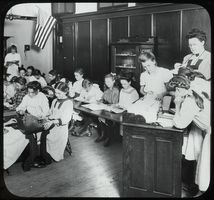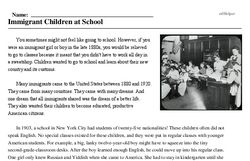Immigrant Children at School
You sometimes might not feel like going to school. However, if you were an immigrant girl or boy in the late 1880s, you would be relieved to go to classes because it meant that you didn't have to work all day in a sweatshop. Children wanted to go to school and learn about their new country and its customs.
Many immigrants came to the United States between 1880 and 1920. They came from many countries. They came with many dreams. And one dream that all immigrants shared was the dream of a better life. They also wanted their children to become educated, productive American citizens.
In 1903, a school in New York City had students of twenty-five nationalities! These children often did not speak English. No special classes existed for these children, and they were put in regular classes with younger American students. For example, a big, lanky twelve-year-old boy might have to squeeze into the tiny second-grade-classroom desks. After the boy learned enough English, he could move up into his regular class. One girl only knew Russian and Yiddish when she came to America. She had to stay in kindergarten until she learned English, but she was so proud when she could finally speak her new country's language. She was the first one in her family to speak English.
No one liked this system of keeping children in a lower grade until they could speak English. The immigrant children felt silly being with younger children. The children who spoke English well were often slowed down in their studies by the immigrants. After a while, most schools had special classes so the immigrants could learn English. These classes taught English to the students in four or five months. Can you imagine moving to a new country and learning a new language so fast? The immigrant children had no choice.
Some new Americans did have special memories about their first day at school. One boy named George Monezis never knew his birthday before his family came to America. He had been born on a Greek island during a war. He did not have a birth certificate. When he came to America, his father wrote down George's birthday as the date he arrived at Ellis Island. George was overjoyed that he could tell his new friends his birthday date.




